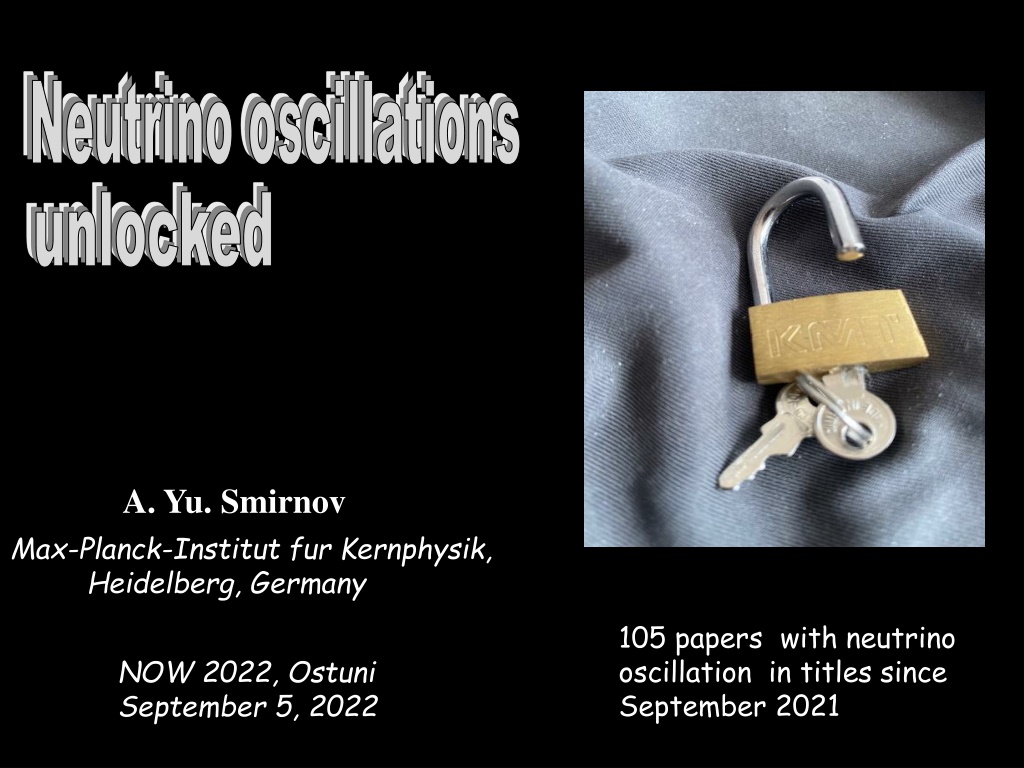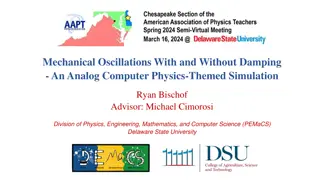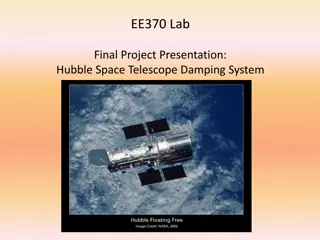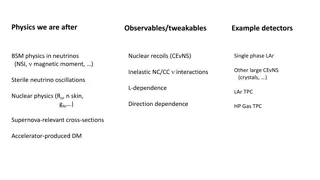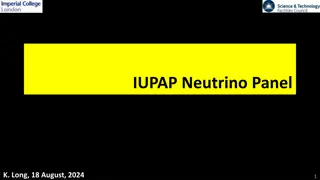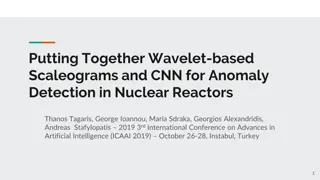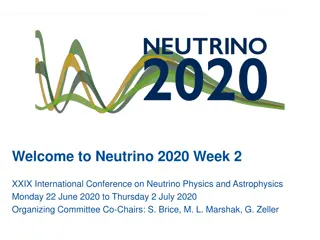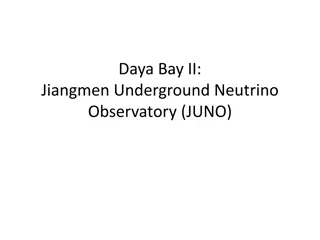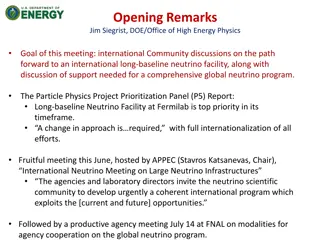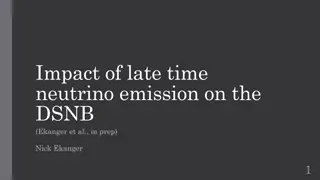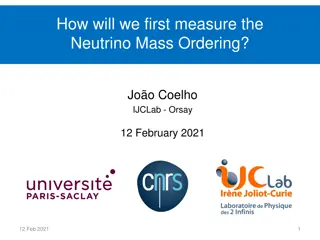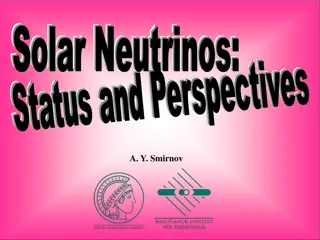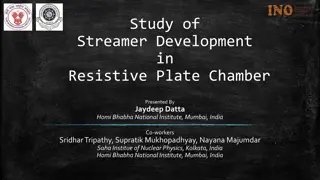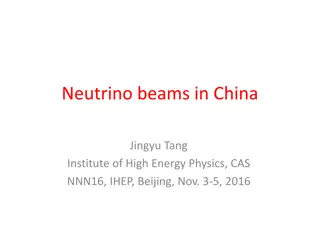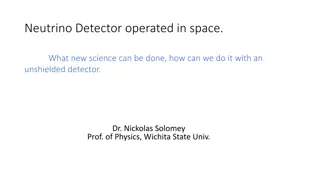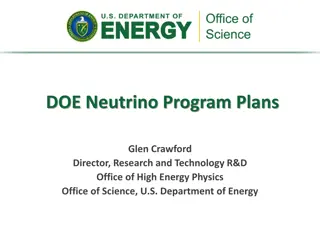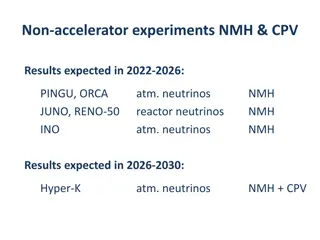Neutrino oscillations unlocked
Unlock the mysteries of neutrino oscillations in vacuum and other media, exploring wave packets, interference, entanglement, and oscillation probabilities. Dive into discussions on matter, vacuum, propagation, and time localization diagrams, shedding light on subtle quantum mechanical effects and tests.
Download Presentation

Please find below an Image/Link to download the presentation.
The content on the website is provided AS IS for your information and personal use only. It may not be sold, licensed, or shared on other websites without obtaining consent from the author.If you encounter any issues during the download, it is possible that the publisher has removed the file from their server.
You are allowed to download the files provided on this website for personal or commercial use, subject to the condition that they are used lawfully. All files are the property of their respective owners.
The content on the website is provided AS IS for your information and personal use only. It may not be sold, licensed, or shared on other websites without obtaining consent from the author.
E N D
Presentation Transcript
Neutrino oscillations unlocked A. Yu. Smirnov Max-Planck-Institut fur Kernphysik, Heidelberg, Germany 105 papers with neutrino oscillation in titles since September 2021 NOW 2022, Ostuni September 5, 2022
Oscillations in vacuum Wave packets of the eigenstates of propagation i production detection 1 h 2 x x x x V Interference: coherence at production propagation, detection Vacuum : VEV V(x,t), interactions of with VEV h V m, h = h(< >) Entanglement with accompanying particles NO: Modification of geometry of x-t, metrics, GR, NO in the GW background effect of propagation in space - time Quantum mechanical effect (superposition, interference) Tests of QM, modification of QM, evolution equation..
Oscillations in media production detection 1 h 2 Classical fields (e.g. magnetic fields) Matter Particle densities From microscopic picture: scattering on individual electrons, to macroscopic one in terms of effective potentials. Interactions with scalar bosons (DM) < > Effective mass squared m2 ~ n ~ z3 increases with decrease of tU Oscillating neutrino medium - treatment as open system
Content Matter , vacuum and propagation Talks on other aspects of oscillations B. Dasgupta, L. Johns M. Blasone
m412 = 1 - 2 eV2 Space-time LSND Localization diagrams
time localization diagram Reflects computations of oscillation amplitude in QFT, visualizes various subtle issues E.Kh. Akhmedov, D. Hernandez, A.Y.S. 1201.4128 [hep-ph] Produced and propagated neutrino state | P>= 1P| 1 > + 2P| 2 > where the wave packets iP = iP(x vit) vi - group velocities Detected state | D>= 1D| 1 > + 2D| 2 > iD = iD(x xD, t tD) - the detection WP Amplitude: projection of propagated state onto detection state: L- baseline For simplicity iD(x xD, t tD) = (x L) iD(t tD) A (L, tD) = < D| P>= i dt iD* (t tD) iP(L vit)
Space time localization diagram Oscillation probability P (L) = dtD|A(L, tD)|2 = dtD [|A1(L, tD)|2 + |A2(L, tD)|2] + 2Re dtD A1(L, tD)*A2(L, tD) interference Ai(L, tD) = dt iD* (t tD) iP(L vit) - generalized WP Further integration over interval of baseline L due to finite sizes of the source and detector The slopes of bands are determined by group velocities
Detection two extreme cases tD >> tP tD << tP short detection coherence time iD(t tD) ~ (t tD) long detection coherence time Ai(L, tD) ~ iD(L/v - tD) Ai(L, tD) ~ iP(L vitD) restoration of coherence if Interference is determined by overlap of produced WP tD >> tsep
Production E.Kh. Akhmedov and A.Y.S. [hep-ph] WP s are determined by localization region of the production process: overlap of localization regions of all particles involved but neutrinos. N N + e- + E.g. in the decay, If N and e- are not detected or their interactions can be neglected localization of process is given by localization of atom N distance The latter is determined by time between two collisions of N, tN x ~ v tN ~ XN c/vN time enhancement factor
Entanglement and correlations If N or/and e- are detected or interact, this may narrow their WP s and therefore the neutrino WP. If e- is detected during time interval te < tN, the size of WP will be determined by te tcoll distance If e- interacts with particles of medium which have very short time between collisions tcoll, then x ~ ctcoll Similar to the EPR paradox time consider emission and interactions of e- as unique process; contributions to its amplitude from different interactions regions appear with random phases k - incoherent Atot = Ak ei k
m412 = 1 - 2 eV2 Propagation coherence LSND
Observing propagation decoherence x t space: separation of wave packets of mass states due to difference of group velocities equivalent to integration over the energy uncertainty f(E) E ~ 1/ x x E x Suppression of interference damping of oscillations Survival probability : Pee = Pee + D(E, L) sin2 2 cos Damping factor for Gaussian WP D(E, L) = exp [- (L/Lcoh)2] Coherence length Lcoh = x Information is not lost and can be restored at detection E2 m2
Decoherence of reactor neutrinos A de Gouvea, V De Romeri, C.A. Termes, 2104.05806 [hep-ph] Bound on size of the WP KamLAND Daya Bay, RENO Expected damping effect Absence of decoherence (damping) effect means L << Lcoh Analysis of data: x > 2.1 x 10-11 cm (90% C.L.) The bound corresponds to the energy resolution of detectors E x ~ 1/ E m2 2E2 x > L
Other studies Daya Bay: decoherence due to finite momentum spread p p /p < 0.23 (95% C.L.) for p = 3 MeV: x ~ 1/ E = 2.8 x 10-11 cm F.P. An, et al, 1608.01661 [hep-ex] JUNO in future may set the limit p /p < 10-2 (95% C.L.) J. Wang et al. 2112.14450 [hep- ex] x > 2.3 x 10-10 cm Decoherence in oscillations active eV scale sterile C.A.Arguelles et al, 2201.05108 [hep-ph] Damping effects in various experiments computed for x = 2.1 x 10-11 cm (as found in A de Gouvea et al). Claims: - decoherence allows to reconcile BEST result with reactor bounds; - results of analysis should be presented in two forms: with and without decoherence
Propagation decoherence and energy resolution integration over the energy resolution of setup another sources of damping E.Kh. Akhmedov and A.Y.S. 2208.03736[hep-ph] R(Er , E) energy resolution in experimental set-up (width E ): - spectrum of produced neutrinos (line), or - energy resolution of a detector f(E, E) WP of produced neutrino in energy representation acts on oscillations, as R does, and can be attached to R(Er, E) Effective resolution function Reff (Er , E) = dE R(Er , E) |f(E, E)|2 For Gaussian f and R, Reff is also Gaussian with width E2 + E2 The problem: to disentangle the two contributions
WPs of reactor neutrinos Source: -decays of fragments N of nuclear fission N N + e- + N quickly thermalise in equilibrium with medium in the moment of decay the average velocity: vN ~ [3T/ mN]-1/2 If N and e- are not detected or their interactions can be neglected, localization of production process is given by localization of N. x ~ v tN ~ XN c/vN tN - time between two collisions of N with other atoms tN ~ [ AA nU vN]-1 AA geometric cross-section AA ~ (2rvdW) 2 Van der Waals radius nU - number density of Uranium x = 2.8 x 10-3 cm
Effect of accompanying particles Consideration of x-t localization of interactions of accompanying particles. Duration of production process is given by the shortest mean free time among particles involved Chain of k processes of secondary interactions till equilibration (thermalization) Electrons have the shortest t = te = Xe/ve Xe is determined by ionization of uranium, eU ... E + A e + A A i Xe = (nU eU)-1 N te t ~ tN /2k x = 2 x 10-5 cm x = (5 10)x 10-5 cm short cut estimation: can be considered as the upper bound
Implications 1. x >> xexp x / xexp = 105 - 106 2. Corresponding energy uncertainty while energy resolution E ~ 105 eV To be sensitive to WP separation energy resolution function should be known with better that 10-5 accuracy E ~ 1 eV For Cr source: x = 1.4 x 10-4 cm 3. Large m2 does not help since oscillatory pattern shows up at L ~ l but Lcoh ~ l ~ 1/ m2 m2 cancels in damping factor 4. If some additional damping is found, it is due to some new physics and not due to WP separation 5. Experiments with L ~ Lcoh ? Lower energies? Widening lines? 6.
Comments and replies B.J.P. Jones, 2209.00561 [hep-ph] Three points appear to undermine that WP separation is unobservable: The statement is based on figures which do not correspond to our computations Causality violation Integration in non-orthogonal basis of entangled recoil We are not making integration over characteristics of recoil Nuclear interactions inside nucleus measure position of initial particle (nucleon) WP are determined by absolute localization of parent particle in the source i.e. wrt other atoms
Comments B.J.P. Jones, 2209.00561 [hep-ph] Figs do not correspond to our estimations No problem with casuality Electron interaction decides light cone should be constructed differently In this setup tN >> tN recoil does not affect WP of neutrinos which is determined by tN
m412 = 1 - 2 eV2 Matter vacuum and propagation LSND
From micro to macro picture From interactions with individual scatteres to effective potential (mean field approximation) Point-like scatterers, a coarse graining coordinate space averaging over macroscopic volumes with large number of particles Summation of potentials produced by individual scatteres. For short range interactions rWI, localization of scatterers should be taken into account Xe >> rWI , e.g. localization of e in atom E.Kh. Akhmedov 2010.07847 [hep-ph] A. Y.S. , Xun-jie Xu e.g., G Fantini, A.G. Rosso, F. Vissani 1802.05781 since ~ 1/p << Xe make sense to consider propagation of neutrino inside atom
Modeling with castle wall profile n b a x Half phases: a b Mixing angles: Va Vb La Lb a b Oscillation probability P = [1 - I2/(1 R2 )] sin2 (n ) I = I( a b, a b ) , R = R( a, b, a, b ) E. Kh. Akhmedov n number of periods = arcos R x For a b << 1 the probability can be reduced to P = sin 22 m(V) sin2 (V) Va La + Vb Lb La + Lb - averaged potential V =
WPs and non adiabatic evolution Partially ionized atoms as the electron density perturbations Number density profile of electrons in atom (O, C, He) is non adiabatic Interplay of non-adiabatic evolution and separation (relative shift) of the WP s leads to new effects: additional averaging of oscillations Applications to Supernova neutrinos M. Kusakabe 2109.11942 [hep- ph] No new effects without WP separation and adiabatic evolution No new effects for very sharp (step-like) density profile
Evolution of WPs WP s are formed at the production (at boundaries) (t x) = dp f(p) p(t x) If there is no absorption or p-dependent interactions, f(p) does not change in the process of evolution p(t x) - plane waves Evolution equation insert (t x): id /dt - H = 0, dp f(p) [id p/dt - H p ] = 0 Superposition principle and linearity of evolution equation solve eq for p, then integrate over p (which takes care about WP nature) No effects predicted in 2109.11942 [hep- ph] In t-x space WP can change form in the course of evolution, but integrated over time result coincides with result in E-p rep. Y. P. Porto-Silva , A Y S 2103.10149 [hep-ph] - scattering H = H ( p) non-linear equation ?
linear generalization of QM T. Gherghetta A. Sherin 2208.10567 [hep-ph] Evolution matrix U(t, tp, (p) (t)) = U0(t, tp) + U1(t, tp, (p) (t)) Standard linear evolution matrix expansion parameter non-linear correction (p) (t) = U(t, tp, (p)) (p)(tp) (p)(t) = (p,0) (t) + (p,1) (t) Produced state Equation for correction (p,1) (t) in coordinate representation: id (1)(t) /dt = H0 (1)(t) + G(t, x, (0)) inhomogeneous term Weinberg 5D operator interaction with scalar state dependent term G P = sin 22 sin 2 - sin m1 + m2 4 m1 - m2 Correction is very small A = 81.5 = A (m1 + m2) 2/v2
Casual framework for non linear QM D E Kaplan S Rajendran 2106.10576 [hep-th] Schrodinger equation for single particle q2 id (t, x) /dt = H0 + d4x1 | (t1, x1)|2 Gr(t x, t1 x1) (t, x) 4 Gr - retarded Green function for scalar q charge, Yukawa coupling constant of and q = m /v
Vacuum and properties of oscillations G.Dvali , L Funcke, 1602.03191 [hep-ph] Neutrino vacuum condensate due to gravity. Order parameter < > = < TC > ~ G = meV - 0.1 eV Cosmological phase transition at T~ G Neutrinos get masses m ~ < > Flavor is fixed by weak (CC) interactions and charged leptons with definite mass generated by usual Higgs field m ~ U( )T < > U( ) < > = diag ( 11, 22, 33), mixing matrix Relic neutrinos form bound states = ( T ) decay and annihilate into (neutrinoless Universe) T< G Symmetry of system SU(3)xU(1) spontaneously broken by neutrino condensate - are goldstone bosons get small masses due explicit symmetry breaking by WI via loops
Mixing and topological defects G.Dvali , L Funcke, T Vachaspati 2112.02107 [hep-ph] string-wall network Symmetry breaking: SU(3) Z2 x Z2 I global strings domain walls Length scale of strings ~ inter-string separation = 1014 m ( /aG) G 7/2 1 meV (self-coupling of string field /scale factor of phase transition) Travelling around string winds VEV < > by the SU(3) transformation: < ( S) > = ( W)T< > ( W) ( W) path - O(3) transformation with angles W = ( W12, W13, W23). After the path lepton mixing changes as over length , W = O(1) U = U( ) ( W) Solar system moves through the frozen string-DW background with v = 230 km/sec. For 6 years (operation of Daya Bay) d = vt = 4 x 1013 m - comparable with expected
S. F Ge and H Murayama, 1904.02518 [hep-ph] VEV or refraction on scalar DM? Ki-Yong Choi, Eung Jin Chun, Jongkuk Kim, 1909.10478 [hep-ph] 2012.09474 [hep-ph] Elastic forward scattering of on background scalars with fermionic mediator Effective potential L VB L L Wolfenstein limit L 1/E tail Resonance: s = m 2 for at rest the resonance energy: 0 m 2 2m ER = For small m resonance at low, observable energies resonance A.Y.S. , V. Valera, 2106.13829 [hep-ph] E 0 ER
Effective m2 meff2 ~ 2EVB = 0 1 , E >> ER y2n 4 m | meff 2| meff2 ~ E , E << ER ER existing observations meff2 = constant - checked down to 0.1 MeV take ER << 0.1 MeV relic ER E For ER = 0.01 MeV: KATRIN, E ~ 1 eV: meff < 2 10-4 eV - undetectable meff2 ~ n ~ (1 + z)3 increased in the past COSMOLOGY while VEV = const meff (0) < 5 10-6 eV: meff (z = 1000) ~ 0.15 eV, Relic , E = 10-4 eV: no problem
Bounds on parameters Ki-Young Choi, Eung Jin Chun, Jongkuk Kim, 2012.09474 [hep-ph] Green band: meff2 = matm2 Upper bounds on y from scattering of neutrinos from SN1987A on DM with zero C- asymmetry and two different masses of mediator f y Similar bound from Ly (relic neutrinos) . m , eV the corresponding resonance energy ER = 0.01 MeV Cosmological bound is satisfied Allowed values: mf < 10-3 eV m < 10-10 eV y< 10-9
Summary Neutrino oscillations the tool for explorations of properties of space and time, subtle aspects of QM fundamental symmetries (beyond measurements of neutrino parameters) Evolution of state and construction of WP in the momentum space commute propagation decoherence is boundary (for linear case) phenomenon (as well as production and detection decoherence) Important study: search for time, space and energy Dependences of oscillation parameters.
Landscape of studies 2021 2022 About 100 papers with Neutrino oscillations in titles Coherence, Entanglement in neutrino oscillations Collective neutrino oscillations Micro vs. macro description Quantumness, Tests of quantum mechanics Oscillations in modified metric, gravity Oscillations in gravitational waves background Mater, medium effects in presence of new interactions (long range forces, DM ), Modification of QM, evolution equation Effects of Lorentz invariance violation, Equivalence principle violation Parameter symmetries All aspects, components, characteristics of oscillations are under investigation. They can be classified as Topics:
